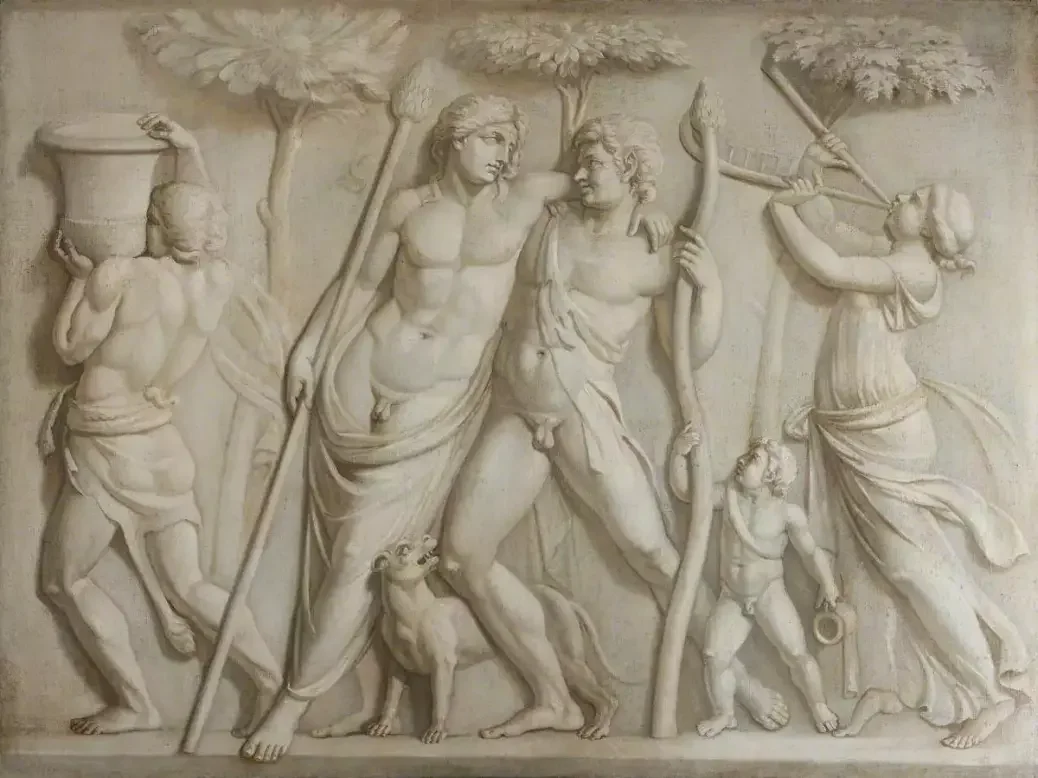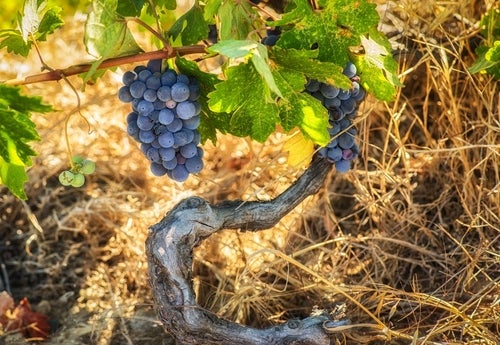
Stuart Walton on the Greek mythological figure of Ampelos, the lover of Dionysos who lends his name to the scientific study of grape varieties.
The deity disposing over wine in Greek mythology is Dionysos, a late Thracian import to the pantheon, who arrives blazing a trail of ecstatic frenzy. He is the ultimate shapeshifter, changing from antic youth to gnarled elder in a mere blink. What is less often remarked upon in the myth is that he was conventionally held to have had a love-life too, albeit a doomed one.
Dionysos’ lover is a satyr, Ampelos, who gives his name to ampelography, the scientific study of the morphology and botanical characteristics of grape varieties. In the imagination of later eras, a satyr was typically a half-formed thing, the upper part man, the lower part sometimes horse, more often goat, the head equipped with horns, the face bestially ugly, the nether parts permanently priapic. A satyr represented the carnal urges of drunkenness and sexual incontinence, and even when he became recognizably wholly humanoid, he was still at the mercy of his own unlovely impulses.
Ampelos: Gilded exception to the beastly rule
Not so Ampelos, who was the gilded exception to the beastly rule. In the Dionysiaca, the most famous of the late Greek epics, composed in the fifth century AD by Nonnus of Panopolis, and the longest complete work of Classical antiquity to have survived, Ampelos is given the kind of rhapsodic description reserved for those most favoured of the gods:
No dainty bloom was yet on a reddening chin, no down yet marked the snowy circles of his cheeks, the golden flower of youth: curling clusters of hair ran loose behind over his silvery-glistering shoulders, and floated in the whispering wind that lifted them with its breath … From his rosy lips escaped a voice breathing honey. Spring itself shone from his limbs; where his silvery foot stept the meadow blushed with roses; if he turned his eyes, the gleam of the bright eyeballs as soft as a cow’s eye was like the light of the full moon. [trans. W.H.D. Rouse, 1940]
An adolescent vision in silver and pink, then. Mention of the full moon, however, more than simply adding the Anacreontic sensual note, prefigures his ghastly fate, in at least one version of the story.
In his hubris, Ampelos flung himself on to the back of a wild bull, scoffing at the full moon, personified by the goddess Selene, that he was every bit as beautiful. Selene, incensed, sent a gadfly to antagonise the bull, which, driven mad by its pitiless biting, threw Ampelos and promptly gored him to death. In his grief, Dionysos then transformed the young corpse into a grapevine, his lover’s blood becoming the first wine. Note that the myth preserves the inference that the first duty of all wine is to be red.
In the alternative version, retailed by Ovid (Fasti 3.407ff), the youth climbs an elm tree to get at the fruit-laden vine branch Dionysos has hung there, only to fall to his death, whereupon the remorseful Dionysos hoists him into the heavens and turns him into the constellation Boötes (the herdsman). This is a somewhat less romantic account, and one more tenuously connected to the foundation of viticulture.
Triumphal return
Ampelos disappeared from the classical pantheon for many centuries, his brief life a marginal episode in the many exploits of Dionysos himself and the forms of ritual consecrated to him. The young satyr only began to stage a triumphal return to the mythical corpus with the first translations of the Dionysiaca in the 17th century, when he finds his way into the poetry of the German lyricist, Martin Opitz.
A representation in oil done in the 1790s by the Irish painter Robert Fagan, in the collection of the National Trust property Attingham Park in Shropshire, is copied from a Roman frieze of around AD 50, itself now in the Museo Nazionale in Napoli. It shows a licentious scene bookended to the left by a muscular steward bearing a wine-jar, and to the right by a thinly draped maenad blowing an aulos (double flute). Between them stand the male lovers in sensual contrapposto, only just wearing diaphanous shifts that are falling brazenly away, each clutching a thyrsos rod, symbol of sexual potency, Dionysos extending a proprietorial arm about the shoulders of his lad. Beneath them, scarcely noticed, a child and a dog gaze up at the inebriated inamorati, transfixed.
The couple’s depiction in classical statuary usually stresses the disparity in age between them, varying from the almost-grown Ampelos gazing up at his man in the marble pair in the Uffizi, Florence, to the same gallery’s more unsettling figure of the kneeling adolescent Ampelos clutching the right leg of the standing Dionysos. His youth is the sustaining metaphorical import of a mythical creature destined to become a grapevine, its annually renewed vigour providing, along with love, the greatest intoxicant known to humanity.






